by Phillip W. Weiss
“After a hard day of basic training, you could eat a rattlesnake.” – Elvis Presley
On December 26, 1970, I reported to Fort Polk, Louisiana, for basic combat training. Contained herein are comments describing the process. These comments are based upon my personal experience as a trainee and are entirely my own.
Fort Polk, Louisiana, is a U.S. Army military base located in western Louisiana. In 1970 it served as a center for basic combat training operations.
Below: map of Louisiana showing the location of Fort Polk. (source: google.com) Fort Polk is situated in a remote part of the state.
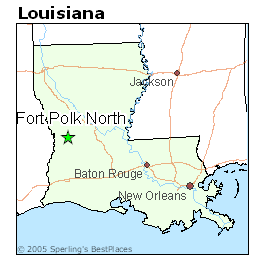
Sometime in December 1970 the army ordered me to report to Fort Polk, Louisiana for basic combat training (BCT). At the time the U. S. Army required that all enlisted personnel successfully complete BCT. BCT was an eight-week long program. I flew from New York City to Houston, Texas; from Houston I flew to Lafayette, Louisiana. At Lafayette I boarded a bus that took me to Fort Polk. After arriving at Fort Polk, actual training did not immediately begin. It was preceded by a so-called “zero week,” a one-week period set aside to give new trainees like myself, at this time known as receptees, an opportunity to acclimate to the new environment. During that time, I was issued a set of uniforms, various pieces of military equipment, and completed certain paperwork. I was assigned a temporary barrack and given light duties.
Below: Reception station, Fort Polk, Louisiana (photo: U.S. Army). The relative calmness of “zero week” belied what was to follow.

After zero-week, basic training commenced. It began with a jolt. On Monday morning, January 4, 1971, at around 4:30 A.M., while we were asleep, drill sergeants stormed into the barracks barking out orders demanding that everyone get up, get moving, and quickly fall in for morning formation. This loud, intense and intimidating onslaught of noise caught everyone’s immediate attention and set the tone for what basic combat training would be like for next eight weeks. I was no longer a receptee. I was now a trainee. Training had begun.
“Regardless of any progress made in the country’s educational institutions, the Army’s business is success in war – and the Army cannot safely neglect any subject that experience has shown to be important to that success.” – General Dwight D. Eisenhower
Below: Trainees at work (photos: U.S. Army). Trainees received instruction on various facets of soldiering.
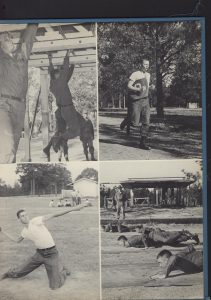
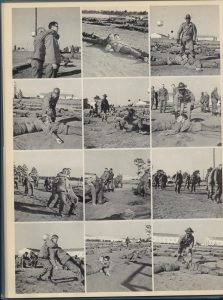
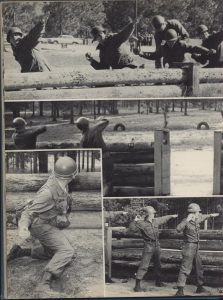

“We find that the Romans owed the conquest of the world to no other cause than continual military training, exact observance of discipline in their camps, and unwearied cultivation of the other arts of war.” – Publius Flavius Vegetius Renatus
Training was rigorous, intense and comprehensive. We were immediately immersed into the military culture. To further reinforce the immersion process, for the first four weeks we were confined to the post. We were taught a wide range of military skills including how to perform close order drills, how to salute, how to march in formation, how to operate a rifle, how to throw a hand grenade, how to use a bayonet, how to engage in hand-to-hand combat, how to read a map, how to make a bed the army way, how to care for equipment, and how to perform physical exercise. But most importantly, we were taught to listen to the drill sergeants, obey orders and perform as part of a team.
“Basic training is horrible. It’s dirty, and it’s ugly. But you learn it’s not just about you. It makes you part of a team, which helps you to survive.” – Rodney Frelinghuysen
Below: Bayonet training. Trainees were taught how to use the M-16 as a sword. (photos: U.S. Army)
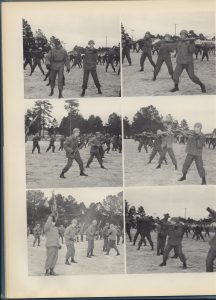
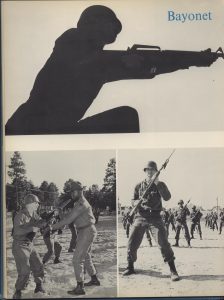
At Fort Polk my training company consisted of five platoons. Each platoon contained approximately fifty men. Each platoon was assigned a barrack, a two-story wooden structure that probably dated back to World War Two. Each barrack had an indoor latrine which included a communal shower area, a row of urinals (without partitions), and a row of toilet bowels (also without partitions). Hygienic and bodily functions were performed in view of others. At least fifty trainees were assigned to a barrack, and probably more. Living conditions were drab. We slept in metal-framed bunk beds; two trainees to a bunk. The bunks contained no safety rails nor did the bunks have ladders to facilitate access to the upper bunk. Each of us was issued bedding. Privacy was non-existent. Personal space was limited to our bunk bed, wall locker and foot locker. We were expected to maintain our personal area, including our personal items, in immaculate condition.
“But bunk and locker drills are simply a means to an end. And that end is developing a soldier’s discipline and attention to even the smallest details.” – Brett & Kate McKay from How to Make a Bed You Can Bounce a Quarter Off Of
The army placed great stress on spit-and-polish. There were frequent inspections. During an inspection, it was not uncommon for the inspecting officer or designee to loudly berate one or more of us for an infraction, almost invariably of a petty nature. To me, new to the army and a civilian through and through, such nitpicking seemed pretentious, theatrical, arbitrary, and even terrifying, nothing more than an attempt to bully us into submission. In reality, however, it was part of a calculated strategy meant to quickly instill discipline and thereby help us become better soldiers.
“There is no question that many of the weaknesses developed in these maneuvers are repeated again and again for lack of discipline. Our troops are capable of the best of discipline. If they lack it, leadership is faulty. A commander who cannot develop proper discipline must be replaced.” – General Lesley J. McNair
Below: Life in the barracks. Conditions were crowded and drab. Privacy was non-existent.(photos: U.S. Army)

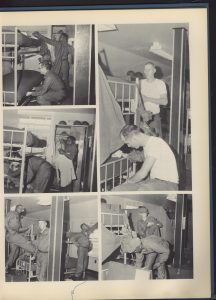
My training company’s chain of command was as follows: trainee (E1 or E-2) -> drill sergeant (E-5) -> senior drill sergeant (E-6) -> first sergeant (E-7) -> executive officer (2nd lieutenant) -> company commander (captain). My platoon had a corporal, but he was outside the chain of command. Each platoon was supervised by a drill sergeant. The drill sergeant was the trainee’s point of contact with the chain of command. My drill sergeant’s name was Senior Drill Sergeant Jimmy L. Carter. All matters pertaining to the operation of the platoon went through him. He was responsible for the platoon and had authority to issue orders. He also functioned as a teacher and roll model. Hence, between the platoon and Drill Sergeant Carter there quickly developed a student-teacher relationship. This relationship was far more intense than anything found in an academic setting. This was the case for two reasons. First, Drill Sergeant Carter was under pressure to convey, and for the platoon to learn, a massive amount of information in a short period of time, and second, the serious purpose of the instruction itself, which was to mold us into soldiers possessing the requisite knowledge and skills needed to perform in a military capacity. This included knowing how to kill. Hence, the stakes were much higher. We also had other instructors who instructed us on various subjects relevant to our training. Primary mode of instruction was through lectures. To aid in the learning process, we needed to be attentive at all times to what was being taught. Rarely did instructors repeat themselves. The success of basic training depended on the quality of the training provided. Inadequate training would mean producing troops ill-equipped to perform successfully as soldiers which in turn would erode the effectiveness of the army and put the national defense of the nation at risk. Without a cadre of competent and dedicated drill sergeants, such as Drill Sergeant Carter, basic combat training would not have been possible. All personnel providing training were active duty military. No civilians were involved.
“I don’t think I could be a foot soldier. I don’t know if I could take orders too good. I’m a little lazy.” – Benicio Del Toro
Below: Drill sergeant instructing trainees at the rifle range. Trainees were carefully monitored to ensure that the rifles were being pointed in a safe direction. (photos: U.S. Army).
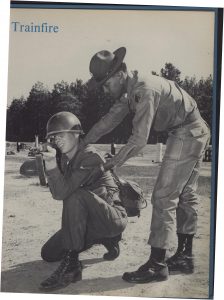
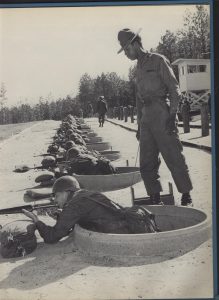
Below: Drill sergeants inspecting the troops. Great stress was placed on neatness and spit-and-polish. (photos: U.S. Army)
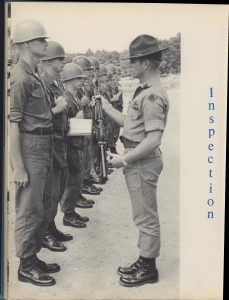
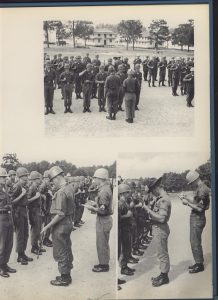
In my training company, trainees came from different ethnic and social backgrounds and from different regions of the United States. Their educational levels ranged from primary school to college graduate. Some were active army; others were serving in the reserves or national guard. Nonetheless, everyone was treated the same. All of us took our participation in the program seriously. Generally, morale was good. This did not mean that we were happy and contented troopers who derived joy from being in basic training. But no one openly questioned or challenged the legitimacy of the army as an institution or the demands imposed on us as trainees. We all cooperated with the program and made a good faith effort not just to get by but to try to do well and learn what was being taught. This in no small measure was due to the effectiveness of the program in keeping us engaged and occupied with tasks designed to transform us into soldiers.
As for the personal qualities of the my fellow trainees, I can state without reservation that they all adhered to the highest standard of conduct. There were no thefts, assaults or fights amongst us. We all managed to get along.
“Yet attention to the individual is the key to success, particularly because American manpower is not only our most precious commodity – it will, in any global war, always be in short supply.” – General Dwight D. Eisenhower
Below: Trainee platoons (photos: U.S. Army) There were approximately fifty trainees per platoon, each commanded by a drill sergeant.
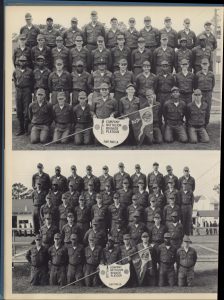
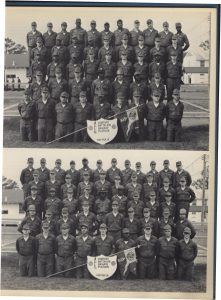
Our training day commenced at around 5:30 AM with revelry and ended at dusk to the sound of retreat. Morning formation was followed by breakfast, then by physical training, then by more training in accordance with the program for that day. Our drill sergeants kept us busy.
Below: Physical training (photos: U.S. Army). The M-16 became an exercise prop. PT usually took place in the morning.
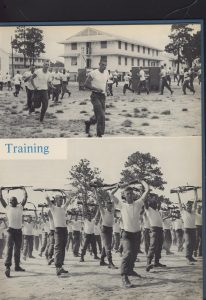
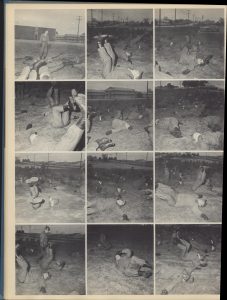
“Sustained rate of fire for the M16/M16A1 Rifle is 12-15 rounds per minute. This is the actual rate of fire that a weapon can continue to deliver for an indefinite length of time without serious overheating.” – Operator’s Manual for Rifle, 5.56- MM, M16 (1005-00-856-6885) Rifle, 5.56-MM, M16A1(1005-00-073-9421)
A critical feature of BCT was instruction on how to operate and maintain the army’s basic combat infantry weapon, the M-16 rifle. Each of us was issued an M-16 rifle. We learned how to disassemble and reassemble the weapon, how to load it, how to maintain it, and how to shoot it with accuracy. To practice our marksmanship, we marched to the rifle range. The rifle range was located several miles from the barracks. Marching to and from the rifle range, in full pack and mostly at quick time or double-time pace, was physically demanding work.
“The soldier is at once the agent, instrument and object of state violence.” -Kenneth T. MacLeish
Below: Trainees at the rifle range. Trainees were taught how to fire the M-16 from different positions (all of which were awkward). (photos: U.S. Army)

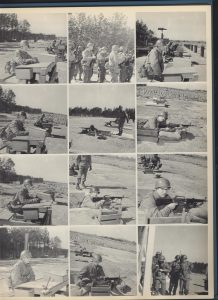
“Completion of boot camp is a wonderful achievement. Basic Training Graduation is going to be one of the most memorable and monumental moments in a service member’s life.” – JD, www.semidelicatebalance.com
Finally, after eight weeks of training came graduation. For us graduation took place on February 26, 1971. We celebrated with a parade. The entire company participated. For many of my fellow trainees, graduation was a landmark event not only for them personally but also for their families, many of whom were in attendance. We were now combat-trained soldiers ready for our next assignments as members of the United State Army.
Below: (left) Graduation and (right) equipment used to transform a civilian into a soldier. (photos: U.S. Army)
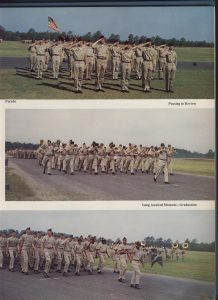

To access the 1971 Fort Polk basic combat training graduation book, go to the link noted below.
https://fortpolk1971.commons.gc.cuny.edu/133-2/
copyright (c) 2016 Phillip W. Weiss

